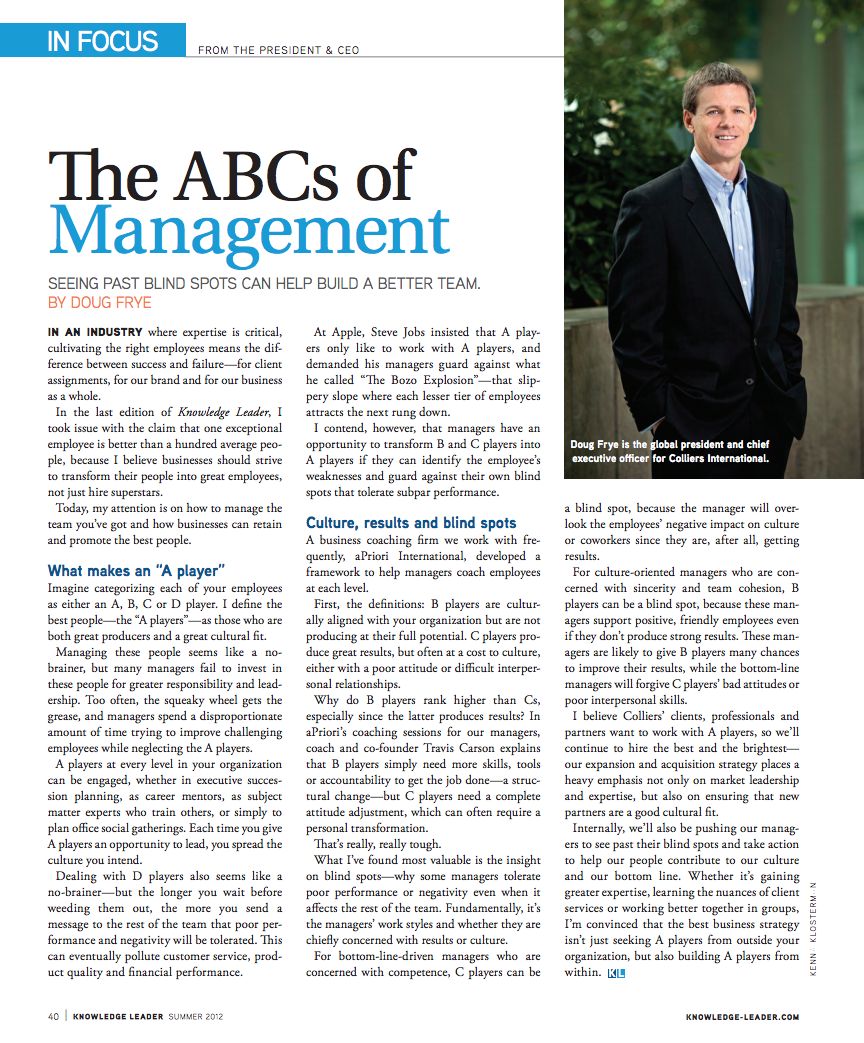The art of managing (up or out) B and C players
Seeing past blind spots can help build a better team
Executive communications
This article, written on behalf of Colliers International’s president and CEO, Doug Frye, originally appeared in the Summer 2012 edition of Knowledge Leader magazine.
IN AN INDUSTRY where expertise is critical, cultivating the right employees means the difference between success and failure—for client assignments, for our brand and for our business as a whole.
In the last edition of Knowledge Leader, I took issue with the claim that one exceptional employee is better than a hundred average people, because I believe businesses should strive to transform their people into great employees, not just hire superstars.
Today, my attention is on how to manage the team you’ve got and how businesses can retain and promote the best people.
What makes an “A player”
Imagine categorizing each of your employees as either an A, B, C or D player. I define the best people—the “A players”—as those who are both great producers and a great cultural fit.
Managing these people seems like a no-brainer, but many managers fail to invest in these people for greater responsibility and leadership. Too often, the squeaky wheel gets the grease, and managers spend a disproportionate amount of time trying to improve challenging employees while neglecting the A players.
A players at every level in your organization can be engaged, whether in executive succession planning, as career mentors, as subject matter experts who train others, or simply to plan office social gatherings. Each time you give A players an opportunity to lead, you spread the culture you intend.
Dealing with D players also seems like a no-brainer—but the longer you wait before weeding them out, the more you send a message to the rest of the team that poor performance and negativity will be tolerated. This can eventually pollute customer service, product quality and financial performance.
At Apple, Steve Jobs insisted that A players only like to work with A players, and demanded his managers guard against what he called “The Bozo Explosion”—that slippery slope where each lesser tier of employees attracts the next rung down.
I contend, however, that managers have an opportunity to transform B and C players into A players if they can identify the employee’s weaknesses and guard against their own blind spots that tolerate subpar performance.
Culture, results and blind spots
A business coaching firm we work with frequently, aPriori International, developed a framework to help managers coach employees at each level.
First, the definitions: B players are culturally aligned with your organization but are not producing at their full potential. C players produce great results, but often at a cost to culture, either with a poor attitude or difficult interpersonal relationships.
Why do B players rank higher than Cs, especially since the latter produces results? In aPriori’s coaching sessions for our managers, coach and co-founder Travis Carson explains that B players simply need more skills, tools or accountability to get the job done—a structural change—but C players need a complete attitude adjustment, which can often require a personal transformation.
That’s really, really tough.
What I’ve found most valuable is the insight on blind spots—why some managers tolerate poor performance or negativity even when it affects the rest of the team. Fundamentally, it’s the managers’ work styles and whether they are chiefly concerned with results or culture.
For bottom-line-driven managers who are concerned with competence, C players can be a blind spot, because the manager will overlook the employees’ negative impact on culture or coworkers since they are, after all, getting results.
For culture-oriented managers who are concerned with sincerity and team cohesion, B players can be a blind spot, because these managers support positive, friendly employees even if they don’t produce strong results. These managers are likely to give B players many chances to improve their results, while the bottom-line managers will forgive C players’ bad attitudes or poor interpersonal skills.
I believe Colliers’ clients, professionals and partners want to work with A players, so we’ll continue to hire the best and the brightest— our expansion and acquisition strategy places a heavy emphasis not only on market leadership and expertise, but also on ensuring that new partners are a good cultural fit.
Internally, we’ll also be pushing our managers to see past their blind spots and take action to help our people contribute to our culture and our bottom line.
Whether it’s gaining greater expertise, learning the nuances of client services or working better together in groups, I’m convinced that the best business strategy isn’t just seeking A players from outside your organization, but also building A players from within.

